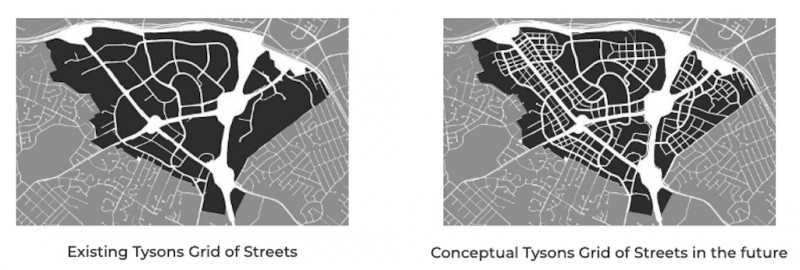Walking and transit are making progress in Tysons, but bikeability is lagging

A bike rack at the Spring Hill Metro by GKJ.
Alternatives to cars have made progress in recent years in Tysons, particularly with the opening of the Silver Line. In many parts of the “edge city,” some or most errands can be done by foot, though often not without facing off against wide crosswalks and long “superblocks.” Multiple public transportation options are available throughout Tysons. But bicycling through Tysons, according to a market study, is still hazardous.
“While Tysons has some bike lanes on certain roads … there is still work to be done to create a connected network,” reads the market study conducted by HR&A Advisors for the Tysons Partnership (note: Tysons Partnership underwrites this coverage but has no editorial oversight.) “Compared to more urban peers like Downtown DC, Tysons lacks protected bike lanes and a denser street network more suitable for biking.”
According to the report, 39% of road segments in Tysons are rated “caution” by Fairfax County’s Department of Transportation. Out of 25 miles of road, only about two miles get Fairfax County’s highest bikeability rating of “preferred.” Nearly 10 miles rank in the most dangerous category.
“Areas of comparable bike friendliness are often isolated and do not necessarily connect neighborhoods or across busy intersections and streets like Route 7,” the report says.
Much of Tysons’ challenge with bikeability is how it was built: as a suburban center of “superblocks” built to optimize car traffic. Fast-moving busy arterials like Route 7 (Leesburg Pike) and Route 123 (Dolley Madison Boulevard and Chain Bridge Road) cut through the center of town, forcing bicyclists to navigate traffic and speed limits built for much larger vehicles.
The study’s conclusion that much of Tysons is still hostile to bicyclists matches how those who do ride bicycles in Tysons have described the experience. A GGWash article last year quotes bicyclists who call the experience “intimidating” and describe close calls as “flirting with death.”
Fairfax County's bike map of Tysons, showing bicycle routes, trails, and bike shops. 
The market study cites Walkscore.com’s bikeability rating, which gives 57% of Tysons addresses the lowest score, “somewhat bikeable.” Only 2% of Tysons addresses are “very bikeable.”
Walkability scores better than bikeability, with 63% of Tysons addresses being rated either somewhat or very walkable, according to Walkscore. But that includes commercial addresses — when residential addresses are sectioned out, more than half of them are in car-dependent locations.
Lingering challenges with bikeability and walkability could help explain why even though more Tysons residents work in Tysons ZIP codes than in any other, only 6% of residents walked or biked to work in 2018, the most recent year in the HR&A report.
Walkability is a major component of the Tysons Comprehensive Plan, the master planning document introduced in 2010 to transform Tysons from a suburban office park to a multi-use urban center. To make Tysons more walkable, the Comprehensive Plan established a goal of building out a series of grid streets, smaller streets to break up Tysons’ superblocks and create safer, more pleasant pedestrian travel routes.
A look at current and conceptual grid of streets in Tysons. Image from Fairfax County. 
That new pedestrian-friendly network can be seen in a handful of new developments such as The Boro, as well as pedestrian and bicycle trails — but most of it hasn’t yet been built.
Although the proportion of residents walking or biking to work hasn’t changed much since the Comprehensive Plan was first implemented, the percentage of residents commuting to work alone by car has declined, from 75% in 2010 to 70% in 2018. Most of that decline is attributable to an uptick in residents taking transit to work, largely due to the opening of the Silver Line.
As in most places, the pandemic threw a wrench into Tysons’ travel and commuting patterns, but it’s not yet clear what commuting will look like on the other side. What does seem clear, however, is that for more people to choose walking and bicycling in Tysons, structural changes will have to come first.
Editor’s note: A member of Greater Greater Washington’s Board of Directors is also a partner with HR&A Advisors. Our board has no influence over editorial decisions, nor content, in any way.
